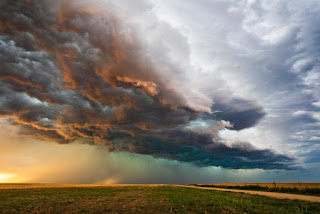
Meteorology is the scientific study of the atmosphere that allows for weather forecasting. Despite the fact that the field has been studied for millennia, no real breakthroughs occurred until the 1700s. Weather forecasting became more feasible in the second half of the twentieth century, after the computer was invented. Meteorology studies variables in the earth’s atmosphere such as water vapor, air pressure, and temperature. It includes the study of weather and climate systems, as well as their global, regional, and local impacts. Meteorology is useful in a variety of fields, including agriculture, transportation, construction, military operations, and even energy production. It is also extremely beneficial to the tourism industry.
Meteorology is derived from the Greek words’meteoros’ and ‘logia,’ and means ‘in the sky’ and’study.’
Around 350BC, Aristotle wrote about meteorology. Many consider him to be the father of meteorology.
Another ancient Greek, Theophrastus, wrote a book called The Book of Signs. It was a book about weather forecasting.
In 1861, the London Times published the first daily weather forecast.
During forest fire seasons, meteorology is useful.
Many films have been made in which meteorology serves as the backdrop for the action. Twister, The Day After Tomorrow, The Perfect Storm, and even Groundhog Day are among these films.
Wind, water vapor, air pressure, and temperature variations are all studied to aid in weather forecasting.
Meteorologists primarily study the troposphere, the lowest layer of the atmosphere, because the higher layers have little influence on the earth’s surface weather. The higher levels usually only have an impact on the weather on Earth’s surface during extreme weather events like tornadoes and hurricanes.
Meteorologists use weather satellite data to make forecasts, but they also use simple instruments like thermometers.
Some people believe that crickets can predict the strength of a weather system. The stronger the approaching weather, the more frequent the chirps.
Meteorologists can track weather patterns and make predictions that can save lives. They can warn people of dangerous approaching weather, which can often help them leave the area and prepare for the storm.
Meteorologists use computers to assist them in making both short-term and long-term weather forecasts.
Meteorologists conduct extensive research on the earth’s weather, including studies on global warming and how pollution affects the weather.
Tornadoes and hurricanes are also studied by meteorologists to better understand how they form.
Because computers cannot do everything that meteorologists can, they cannot fully replace them. Humans are still required to select the best method of weather prediction.
A person must have pattern recognition skills, as well as knowledge of forecast model performance and biases, among other things, to predict weather.
Weather forecasts are even used in the stock market. Temperature and rain forecasts have an impact on agriculture, and thus the value of commodities in the farming industry.
Forecasts are used by air traffic controllers and flight crews to help keep passengers safe.
Weather enthusiasts can pursue a variety of careers, including becoming the Weather Man or Weather Girl on television news channels.
Frequently Asked Questions about Meteorology
Here are some of the most common questions people search about meteorology, answered in detail:
What is meteorology?
Meteorology is the scientific study of the atmosphere, the layer of gases surrounding Earth. It focuses on understanding weather phenomena like wind, rain, snow, sunshine, thunderstorms, and hurricanes. Meteorologists use physics, chemistry, and math to observe, analyze, and predict atmospheric conditions.
Why is weather forecasting important?
Accurate weather forecasts are crucial for many reasons. They help people plan their daily activities, prepare for severe weather events, and make informed decisions in various sectors like agriculture, aviation, and emergency management. Farmers can adjust planting and harvesting schedules based on forecasts. Airlines can optimize flight routes to avoid turbulence and storms. Early warnings about severe weather allow communities to take precautions and minimize potential damage.
How do meteorologists forecast the weather?
Weather forecasting involves a complex process that combines sophisticated technology and scientific expertise. Meteorologists gather data from various sources, including weather stations, satellites, radar systems, and atmospheric balloons. This data provides information about temperature, pressure, humidity, wind speed and direction, and cloud cover. Powerful computers then run complex models that analyze this data and predict how atmospheric conditions will change over time.
Why aren’t weather forecasts always accurate?
The atmosphere is a chaotic system, meaning small changes in initial conditions can lead to significantly different outcomes. This inherent complexity makes long-term forecasts less accurate than short-term ones. Additionally, weather models rely on vast amounts of data, and any gaps or inaccuracies in the data can affect the forecast. However, forecasting has become significantly more accurate in recent decades due to advancements in technology and computer modeling.
What are the different types of clouds, and what do they tell us about the weather?
There are many different cloud types, each with its own unique characteristics and association with specific weather conditions. Here are some common types:
- Cumulus: These puffy, white clouds often indicate fair weather and afternoon showers.
- Cirrus: Thin, wispy clouds made of ice crystals, often signifying fair or changing weather.
- Stratus: Gray sheet-like clouds that can bring drizzle or light rain.
- Altostratus: Mid-level sheet clouds that can sometimes produce light rain or snow.
- Nimbostratus: Dark, featureless clouds that bring continuous rain or snow.
- Cumulonimbus: Towering, dark clouds associated with thunderstorms, hail, and heavy precipitation.
What is the difference between weather and climate?
Weather refers to the short-term state of the atmosphere, including temperature, precipitation, wind, humidity, and cloud cover. It can change rapidly over hours or days. Climate, on the other hand, refers to the average weather conditions in a specific location over a long period (typically 30 years or more). Climate encompasses patterns of temperature, precipitation, wind, sunshine, and other weather elements. While weather can be unpredictable, climate is a more stable characteristic of a region.
What is the impact of climate change on weather patterns?
Climate change, caused by human activities like burning fossil fuels, is altering weather patterns globally. The Earth’s average temperature is rising, leading to more extreme weather events like heatwaves, droughts, floods, and stronger storms. Climate change also disrupts precipitation patterns, affecting agricultural yields and water resources.
These are just a few of the many questions people have about meteorology. As the field continues to evolve, meteorologists will play an increasingly crucial role in understanding and predicting the complex dynamics of our atmosphere.









